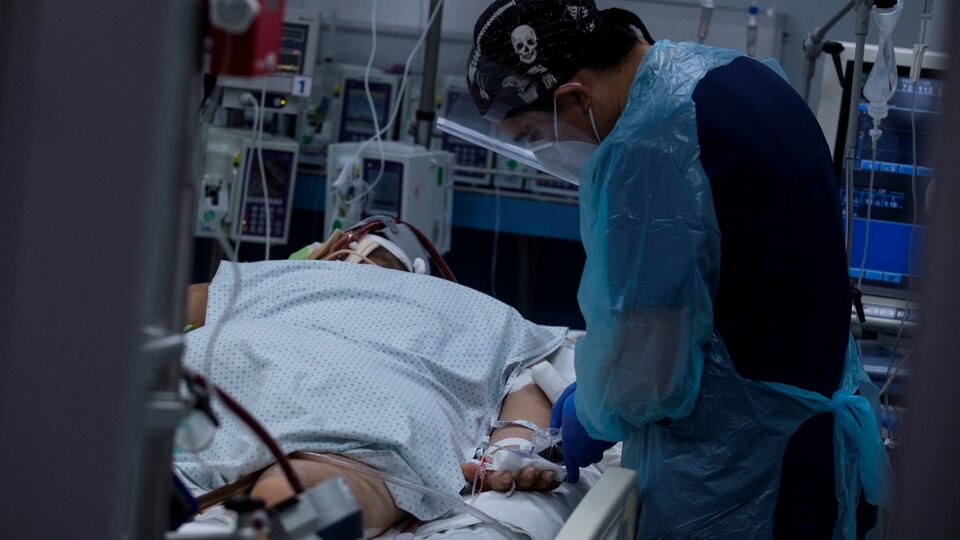
[ad_1]
Uruguay is going through an alarming period. Whoever was an example of the world in managing the pandemic has today a health system on the verge of collapse, the forecast of more than 1,200 deaths in April, a growing number of cases and a government that continues to avoid cracking down on mobility.
The pandemic took a long time to reach Uruguay, and for nine months it remained at more than acceptable numbers to the point of being regarded by the rest of the world as an exception. Today it is the fifth country with the most daily deaths per million inhabitants, according to the Our World in Data website.
In addition, it is the country with the highest number of new cases per million inhabitants in the world for several days. Currently, accumulates 149,430 positive cases (31,302 active) and 1,595 deaths, far from the 19,399 infections (5,750 active) and 181 deaths recorded as of December 31, 2020.
Despite this, the President of Uruguay, Luis Lacalle Pou, still proclaims the so-called “responsible freedom”, accompanied by lukewarm measures such as the suspension of face-to-face classes – until May 3 or the closure of gymnasiums and duty-free shops on the border with Brazil.
Without results
When the trend of daily infections started to increase between February and March, Lacalle Pou announced measures that would be in place until April 12 and then extended until April 30. “One thing is clear: the measures that have been taken are. Is clear that they did not give the expected result,” said the Colorado Party MP (PC, center-right) Nibia reisch.
According to the legislator of the ruling coalition – with the National Party (PN, center-right), the Independent Party (PI, center-left), Cabildo Abierto (CA, right) and the People’s Party (PG, right ) -, it is necessary to leave open only “essential stores”, as has been done all over the world.
“We know the economic and social consequences that this has, but if this situation is not controlled, the consequences can be more important in the future”, underlines the deputy. If he recognizes the efforts of the health authorities in terms of increasing the resources in intensive care, he stresses that measures “a little more restrictive” are necessary.
For its part, Daniel OleskerThe senator of the Large Front (FA, on the left), assures Efe that the current situation is “dramatic and critical” and has only worsened since the measures announced. “The decision not to take health measures is due to the fact that any stricter regulation of mobility requires financial resources and this government has decided that the tax is a priority over the health”, underlines the opponent.
From the executive, they pointed out that the increase is due to the fact that the population has not reduced its mobility and the arrival of the P1 variant from Brazil. But the Honorary Scientific Advisory Group (GACH), which advises the Executive on the management of the pandemic, had already warned against this situation in its report of February 7, in which it warned that it was necessary to restrict mobility to avoid the current levels of circulation of the virus.
GACH recommended restricting mobility between midnight and 6 a.m. closing bars or shops and doing everything possible to maintain school attendance. Faced with this, the executive decided not to ban traffic, to keep shops open, bars open until midnight and schools closed. The mathematician and member of GACH Ines Fariello He stressed this Tuesday on Teledoce that, if the current average of deaths is maintained, it is estimated that it is only in April that there will be more than 1,200.
For his part, the president of the Uruguayan Society of Intensive Medicine (SUMI), Julio Pontet, points out that the ITCs are experiencing “the worst situation” since the start of the pandemic, both in occupied beds and in human resources.
Lack of medication, worry about oxygen, the current bed occupancy rate of 77% and a high degree of stress, fatigue or staff exhaustion are just a few of the concerns. of those who work on the front lines and seek to save lives.
Faith in the vaccine
Despite the unchecked increase, with around half of new cases unrelated epidemiologically and deaths continue to rise, Uruguay has a light at the end of the tunnel in its vaccination plan. In this regard, the virologist Juan Cristina He says that “the most effective measure” the country has today is vaccination as quickly and widely as possible.
Since March 1, when Uruguay started its vaccination plan918,118 were inoculated with the first dose of Pfizer or Coronavac and 213,773 with the second, totaling 32.28 percent of the population. “In any case, we are in a very worrying situation with stress in the health sector and particularly in intensive medicine, which is really important. I think it is a multifactorial problem”, considers Cristina.
His big concern is that the country is reaching 70 percent of people vaccinated to achieve the so-called herd effect. “In my humble opinion, this is our only way out beyond pursuing non-pharmacological measures”, concludes the virologist.
With that on the table, the truth is that the government’s desire to “protect the month of April” is not producing the desired effects. Souls who die alone in hospital beds are dying more and more and the country that set an example for the world in 2020 today is not finding the way.
.
[ad_2]
Source link
 Naaju Breaking News, Live Updates, Latest Headlines, Viral News, Top Stories, Trending Topics, Videos
Naaju Breaking News, Live Updates, Latest Headlines, Viral News, Top Stories, Trending Topics, Videos